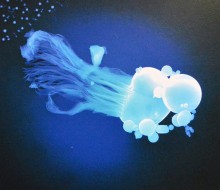Many years ago I was dragged to a movie about J. Krishnamurti (a philosopher and spiritual teacher; there’s more in this Wikipedia essay) which, for some reason, featured Whirling Dervishes amongst many other topics. Watching those dervishes was hypnotic and I now find out it was also an experience in physics, according to a Nov. 26, 2013 news item on ScienceDaily,
A force that intricately links the rotation of the Earth with the direction of weather patterns in the atmosphere has been shown to play a crucial role in the creation of the hypnotic patterns created by the skirts of the Whirling Dervishes.
This is according to an international group of researchers who have demonstrated how the Coriolis force is essential for creating the archetypal, and sometimes counterintuitive, patterns that form on the surface of the Whirling Dervishes skirts by creating a set of very simple equations which govern how fixed or free-flowing cone-shaped structures behave when rotating.
The Nov. 26, 2013 Institute of Physics (IOP) news release on EurekAlert (also on the IOP website but dated Nov. 27, 2013), which originated the news item, gives an explanation of Whirling Dervishes and describes the research further,
The Whirling Dervishes, who have become a popular tourist attraction in Turkey, are a religious movement who commemorate the 13th-century Persian poet, Rumi, by spinning on the spot and creating mesmerising patterns with their long skirts. A YouTube video of the Whirling Dervishes in action can be viewed here: https://www.youtube.com/watch?v=L_Cf-ZxDfZA.
Co-author of the study James Hanna, from Virginia Polytechnic Institute and State University, said: “The dancers don’t do much but spin around at a fixed speed, but their skirts show these very striking, long-lived patterns with sharp cusp-like features which seem rather counterintuitive.”
Hanna, along with Jemal Guven at the Universidad Nacional Autónoma de México and Martin Michael Müller at Université de Lorraine, found that it was the presence of a Coriolis force that was essential in the formation of the different patterns.
The Coriolis effect accounts for the deflection of objects on a rotating surface and is most commonly encountered when looking at the Earth’s rotations and its effect on the atmosphere around it. The rotation of the Earth creates the Coriolis force which causes winds to be deflected clockwise in the Northern Hemisphere and anti-clockwise in the Southern Hemisphere – it is this effect which is responsible for the rotation of cyclones.
“Because the sheet is conically symmetric, material can flow along its surface without stretching or deforming. You can think of the rotating Earth, for example, with the air of the atmosphere free to flow around it.
“The flow of a sheet of material is much more restrictive than the flow of the atmosphere, but nonetheless it results in Coriolis forces. What we found was that this flow, and the associated Coriolis forces, plays a crucial role in forming the dervish-like patterns,” Hanna continued.
By providing a basic mathematical description of the spinning skirts of the Dervishes, the researchers hope their future research will discern how different patterns are selected, how stable these patterns are and if gravity or any other effects make a qualitative difference.
The news release notes,
The equations, which have been published today, 27 November,[2013], in the Institute of Physics and German Physical Society’s New Journal of Physics, were able to reproduce the sharp peaks and gentle troughs that appear along the flowing surface of the Dervishes’ skirts and showed a significant resemblance to real-life images.
Here’s a link to and a citation for the paper,
Whirling skirts and rotating cones by Jemal Guven, J A Hanna, and Martin Michael Müller. New Journal of Physics Volume 15 November 2013 doi:10.1088/1367-2630/15/11/113055 Published 26 November 2013
© IOP Publishing and Deutsche Physikalische Gesellschaft
This paper is open access.
While the Whirling Dervishes and the fabric in their clothing provide insights into aspects of physics, ballet dancers are providing valuable information to neuroscientists and geriatric specialists with pirouettes, according to a Sept. 26, 2013 news item on ScienceDaily,
Scientists have discovered differences in the brain structure of ballet dancers that may help them avoid feeling dizzy when they perform pirouettes.
The research suggests that years of training can enable dancers to suppress signals from the balance organs in the inner ear.
The findings, published in the journal Cerebral Cortex, could help to improve treatment for patients with chronic dizziness. Around one in four people experience this condition at some time in their lives.
The Imperial College of London (ICL) Sept. 26, 2013 news release on EurekAlert (also on the ICL website but dated Sept. 27, 2013), which originated the news item, describes dizziness, this research, and ballet dancers’ unique brains in more detail,
Normally, the feeling of dizziness stems from the vestibular organs in the inner ear. These fluid-filled chambers sense rotation of the head through tiny hairs that sense the fluid moving. After turning around rapidly, the fluid continues to move, which can make you feel like you’re still spinning.
Ballet dancers can perform multiple pirouettes with little or no feeling of dizziness. The findings show that this feat isn’t just down to spotting, a technique dancers use that involves rapidly moving the head to fix their gaze on the same spot as much as possible.
Researchers at Imperial College London recruited 29 female ballet dancers and, as a comparison group, 20 female rowers whose age and fitness levels matched the dancers’.
The volunteers were spun around in a chair in a dark room. They were asked to turn a handle in time with how quickly they felt like they were still spinning after they had stopped. The researchers also measured eye reflexes triggered by input from the vestibular organs. Later, they examined the participants’ brain structure with MRI scans.
In dancers, both the eye reflexes and their perception of spinning lasted a shorter time than in the rowers.
Dr Barry Seemungal, from the Department of Medicine at Imperial, said: “Dizziness, which is the feeling that we are moving when in fact we are still, is a common problem. I see a lot of patients who have suffered from dizziness for a long time. Ballet dancers seem to be able to train themselves not to get dizzy, so we wondered whether we could use the same principles to help our patients.”
The brain scans revealed differences between the groups in two parts of the brain: an area in the cerebellum where sensory input from the vestibular organs is processed and in the cerebral cortex, which is responsible for the perception of dizziness.
The area in the cerebellum was smaller in dancers. Dr Seemungal thinks this is because dancers would be better off not using their vestibular systems, relying instead on highly co-ordinated pre-programmed movements.
“It’s not useful for a ballet dancer to feel dizzy or off balance. Their brains adapt over years of training to suppress that input. Consequently, the signal going to the brain areas responsible for perception of dizziness in the cerebral cortex is reduced, making dancers resistant to feeling dizzy. If we can target that same brain area or monitor it in patients with chronic dizziness, we can begin to understand how to treat them better.”
Another finding in the study may be important for how chronic dizzy patients are tested in the clinic. In the control group, the perception of spinning closely matched the eye reflexes triggered by vestibular signals, but in dancers, the two were uncoupled.
“This shows that the sensation of spinning is separate from the reflexes that make your eyes move back and forth,” Dr Seemungal said. “In many clinics, it’s common to only measure the reflexes, meaning that when these tests come back normal the patient is told that there is nothing wrong. But that’s only half the story. You need to look at tests that assess both reflex and sensation.”
For the curious, here’s a link to and a citation for the paper,
The Neuroanatomical Correlates of Training-Related Perceptuo-Reflex Uncoupling in Dancers by Yuliya Nigmatullina, Peter J. Hellyer, Parashkev Nachev, David J. Sharp, and Barry M. Seemungal. Cereb. Cortex (2013) doi: 10.1093/cercor/bht266 First published online: September 26, 2013
Delightfully, this article too is open access.
I love these kinds of stories where two very different branches of science find information of interest in something as ordinary as spinning around.
![Courtesy: Imperial College of London (downloaded from: http://www3.imperial.ac.uk/newsandeventspggrp/imperialcollege/newssummary/news_26-9-2013-17-43-4]](http://www.frogheart.ca/wp-content/uploads/2013/11/BalletPirouette-300x207.jpeg)
Courtesy: Imperial College of London (downloaded from: http://www3.imperial.ac.uk/newsandeventspggrp/imperialcollege/newssummary/news_26-9-2013-17-43-4]
Here are some Whirling Dervishes,
![Istanbul - Monestir Mevlevi - Dervixos dansaires Credit: Josep Renalias [downloaded from: http://en.wikipedia.org/wiki/File:Istanbul_-_Monestir_Mevlevi_-_Dervixos_dansaires.JPG]](http://www.frogheart.ca/wp-content/uploads/2013/11/Whirling-DervishesJPG-300x199.jpg)
Istanbul – Monestir Mevlevi – Dervixos dansaires Credit: Josep Renalias [downloaded from: http://en.wikipedia.org/wiki/File:Istanbul_-_Monestir_Mevlevi_-_Dervixos_dansaires.JPG]
ETA Nov. 28, 2013: I was most diverted by the
Nov. 27, 2013 Virginia Tech news release (also on
EurekAlert) which describes how two physicists and an engineer came to study Whirling Dervishes,
James Hanna likes to have fun with his engineering views of physics.
So when he and his colleague Jemal Guven visited their friend Martin Michael Müller in France on a rainy, dreary day, the three intellects decided to stay in. Guven, absent-mindedly switching between channels on the television, stumbled upon a documentary on whirling dervishes, best described as a Sufi religious order, who commemorate the teachings of 13th century Persian mystic and poet Rumi through spinning at a fixed speed in their floor length skirts.
“Their skirts showed these very striking, long-lived patterns,” Hanna, the engineer, recalled.
The film caused physicists Guven and Müller to think about structures with conical symmetry, or those shapes that can be defined as a series of straight lines emanating from a single point. By contrast, Hanna, the engineer with a physicist’s background, thought about rotating flexible structures, namely strings or sheets.
![Daan Roosegarde's Intimacy Garment [downloaded from: http://www.innovationintextiles.com/smart-textiles-nanotechnology/smart-fabrics-europe-2013-conference-review/]](http://www.frogheart.ca/wp-content/uploads/2013/11/Daan-Roosegarde-INTIMACY-GARMENT-300x200.jpg)
![Dancers during the Olympic closing ceremony [Downloaded from: http://www.waldemeyer.com/olympic-ceremonies]](http://www.frogheart.ca/wp-content/uploads/2013/11/MoritzWaldemeyerOlympics-300x199.jpg)
![[downloaded from: http://ubpost.mongolnews.mn/?p=6790#]](http://www.frogheart.ca/wp-content/uploads/2013/11/wreath-300x189.jpg)

![[Downloaded from: https://en.wikipedia.org/wiki/Graph_database]](http://www.frogheart.ca/wp-content/uploads/2013/11/GraphDatabase-300x212.png)

![[downloaded from http://www.nanotec.or.th/en/?p=5659]](http://www.frogheart.ca/wp-content/uploads/2013/11/NANOTEC_2014pavilion-300x227.png)
![Courtesy: Imperial College of London (downloaded from: http://www3.imperial.ac.uk/newsandeventspggrp/imperialcollege/newssummary/news_26-9-2013-17-43-4]](http://www.frogheart.ca/wp-content/uploads/2013/11/BalletPirouette-300x207.jpeg)
![Istanbul - Monestir Mevlevi - Dervixos dansaires Credit: Josep Renalias [downloaded from: http://en.wikipedia.org/wiki/File:Istanbul_-_Monestir_Mevlevi_-_Dervixos_dansaires.JPG]](http://www.frogheart.ca/wp-content/uploads/2013/11/Whirling-DervishesJPG-300x199.jpg)